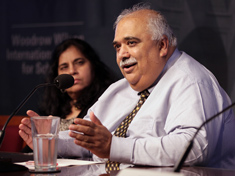-
Dr. Harshad Sanghvi: Reducing Maternal and Child Deaths Requires Better Trained, Empowered Health Workers
October 17, 2014 By Sarah Meyerhoff
Technological solutions, like improved equipment and logistical tools, have been trumpeted as keys to finally ending preventable maternal and child deaths. “But it’s not just technology innovation that we need; it is systems innovation,” says Dr. Harshad Sanghvi in this week’s podcast.
Technological solutions, like improved equipment and logistical tools, have been trumpeted as keys to finally ending preventable maternal and child deaths. “But it’s not just technology innovation that we need; it is systems innovation,” says Dr. Harshad Sanghvi in this week’s podcast.
Improving training for health workers is one of the best investments towards improving maternal and child health, says Sanghvi, vice president of innovation and medical director of the global health NGO Jhpiego.
“One of the big challenges in our environment is not only acquiring the skills, but maintaining the skills,” he says. Through experience, Sanghvi says he’s learned that training doesn’t necessarily stick unless there’s follow-up and spot checks after the initial lesson:
Imagine a frontline health worker who doesn’t often see postpartum hemorrhage, but when postpartum hemorrhage occurs, she’s got to be ready to do it. If you haven’t practiced a skill for a while, then that skill disappears.
Giving health workers the chance to practice skills under the conditions they’re likely to be working under is also important. “Training them in big city nursing schools and midwifery schools is just not sufficient if we want them to practice in rural areas,” he says, and you can work with an entire team at once by going to where they are.
Empowered Health Workers Are More Effective
Better tracking and health administration systems can help identify where knowledge gaps among staff have formed. In Nepal, for example, Jhpiego helped professional associations conduct a brief survey on how clinics screened for and treated preeclampsia which revealed a lack of understanding on how basic blood and protein tests can prevent the often-life threatening condition. Through phone calls, officials then monitored how workers and clinic administrators were implementing needed changes.
The most effective training programs provide not only skills to health workers, but also the confidence and ability to deploy them
“Using this combined approach, this blended approach of training as well as governance, actually has a better chance of making impact than just a training approach,” says Sanghvi.
But the most effective training programs provide not only skills to health workers, but also the confidence and ability to deploy them, he says.
In Afghanistan, Jpheigo partnered with local health officials to not only strengthen curricula in midwifery schools, but provide nursery and nanny services to the many students with children and teach English and computer skills so they could access a much wider range of information after schooling.
One student from this program was able to perform a manual placenta removal – a very difficult procedure – on a patient who was bleeding heavily after labor and whose husband refused care for her three times before relenting. She did this despite knowing that failure might have cost her her life in such a patriarchal society.
“She was empowered enough to stand up to this guy,” says Sanghvi, “and she was also empowered by the knowledge and the competency and the capability and the proficiency that she had.”
Sanghvi spoke at the Wilson Center on September 30.
Friday podcasts are also available for download on iTunes.
Topics: Afghanistan, development, Dot-Mom, education, Friday Podcasts, gender, global health, India, maternal health, MDGs, Nepal, podcast, South Asia, youth
 A Publication of the Stimson Center.
A Publication of the Stimson Center.




